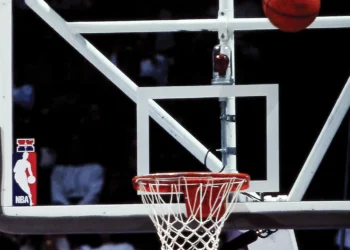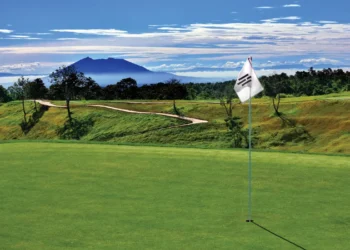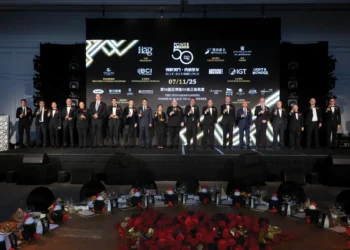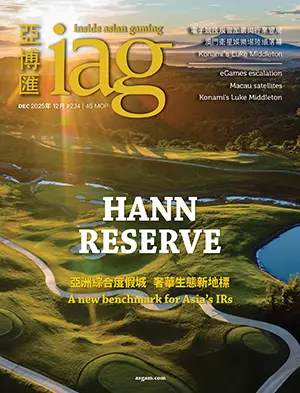Japan’s preparations for integrated resorts are hitting pachinko harder than the actual casinos ever will.
Japan won’t open its first integrated resort for years, if ever, but the IRs already have their first loser, the country’s unique and ubiquitous pachinko business. Pachinko has become the target of efforts to combat problem gambling. That’s kicking an industry when it’s down: like the broad Japanese economy, pachinko has been in decline for more than two decades and the game shows no signs of breaking its losing streak.
Japan’s version of upright pinball – players flick a dial to send five gram, 11 millimeter stainless steel balls cascading through a grid of posts where finding the right holes wins more balls – originated in the 1920s and flourished into the 1990s. Pachislot became part of the mix in 1965; current models are simple slot machines with video backgrounds and buttons players push to stop the spinning reels.
Pachinko boomed with the introduction of video to machines in the 1980s. Player numbers peaked in 1995 at nearly 30 million in a population of 125 million, according to the Japan Productivity Center White Paper on the Leisure Industry issued in 2016. Some estimate the current player population at below 10 million.
Parlor numbers, 18,000 in 1995, fell to 10,258 at the end of last year, according to Tokyo’s Yano Research Institute, split among 3,244 owners. Pachinko turnover – equivalent to cash-in for casino gaming machines – reached a record ¥33 trillion in 2005 (US$309 billion at the time) and has decreased by a third since. Still, pachinko’s ¥22 trillion turnover represents 4% of Japan’s GDP and the industry employs 400,000.
Customarily an after-work diversion and often occupying prime real estate around train stations, pachinko (and pachislot, operating in tandem and collectively termed pachi) is, from a legal perspective, simple amusement, where players win balls or tokens that can be traded for prizes at the parlor. In a legal gray area, the player can then take their prize outside the parlor to exchange it for cash. Tokyo Union Circulation exchange counters, with bright orange TUC signs, are hidden in plain sight near the capital’s pachinko parlors.

TARGET PRACTICE
That gambling element has drawn scrutiny in connection with efforts to legalize IRs in Japan.
“Because of growing public attention to prevention of gambling addiction with IR laws in mind, [greater regulation] is being driven by government, not only for the pachinko/pachislot industry but also for government-controlled gambling,” gaming machine manufacturer Sega Sammy, a partner in Korea’s Paradise City IR, said in a statement to Inside Asian Gaming. “The administration and the industry decided that the regulation on the payout rate would be necessary as one of the solutions to prevent addiction.”
Regulations that took effect in February cut pachinko jackpot yields from 2,400 balls to 1,500 and pachislot jackpots by an identical 37.5% from 480 tokens to 300. The National Police Agency declared that the maximum profit for four hours of play has been set below ¥50,000; it was more than ¥100,000 under prior regulations.
The new measures, proposed last year by Prime Minister Shinzo Abe’s cabinet, include self-exclusion options and betting curbs on government-run horse, boat, motorcycle and bicycle racing. Polling has shown that the Japanese public continues to oppose casino legalization, with problem gambling a key concern.
The pachinko and betting restrictions constitute Japanese authorities’ first explicit steps to address problem gambling, which they commonly call “gambling addiction.” IR supporters promise gambling addiction legislation ahead of the IR Implementation Bill, the final legislative step for casino legalization. The addiction bill, including government programs to promote recovery and encourage responsible play, has been introduced in the Diet but not enacted.
A 2013 survey by the Health, Labor and Welfare Ministry estimated more than five million gambling addicts in Japan, well above global norms. ReNeA Japan CEO and founder Masa Suganuma, a former gaming machine executive, calls that “very silly information.” A more recent academic study puts the figure for pachinko far lower, at 900,000.

BRIGHT LINE
Pachinko industry participants and observers see motivations beyond problem gambling behind steps to curb pachinko. Amusement Japan Chief Editor Tsuyoshi Tanaka, who predicted years ago that regulators would target pachinko to set the stage for casinos, believes it’s about drawing a bright line between pachinko and casino gambling.
Pachinko has a seedy reputation. The yakuza underworld once controlled prize exchanges, but they’ve been largely driven from the business, experts say. Parlor operations remain dominated by ethnic Koreans, 30% of them from North Korea, who gravitated to pachinko because many other Japanese business people shunned it. Pachinko also served for decades as a funding conduit to North Korea, though the flow has diminished this century.
The new regulations will likely hasten pachinko’s longstanding decline, a trend that results from a population decrease, changing tastes in entertainment and gaming options with more compelling content, starting with gaming consoles and now smartphones.
“Added restrictions are likely to put hundreds, if not thousands, of parlors out of business,” Union Gaming’s Grant Govertsen, who follows Hong Kong listed pachinko parlor owner Dynam Holdings, says. “This in turn will provide the bigger operators like Maruhan and Dynam the opportunity to roll-up the industry at attractive valuations. Bottom line, look for further consolidation of the industry while at the same time seeing the total number of parlors shrink.”

IMAGE PROBLEMS
Despite using anime and other trendy content, uptake of pachinko remains depressed. “For young people, pachinko is not cool,” Tanaka, who has covered pachi since 2000, says. “It costs too much money compared to smartphone games. There is no mobility. It is not connected with social networking.”
IRs will also contribute to the decline, according to a consumer survey of 4,900 adults, including pachinko players and non-players that Tanaka, a former marketing executive, conducted over the past two years. If a casino opened within two hours of their home, 8% of the sample said they would play there. Among high frequency pachinko players, the industry’s best customers, playing at least three times a week, 46% said they would play at the casino. But Tanaka emphasizes that competition will occur within a limited geographical area since there will be no more than three IRs in Japan to start. Add the proposed ¥6,000 casino entry tax for Japan residents and it’s likely pachinko will remain a quotidian pastime with casinos potentially an occasional indulgence.
“The pachinko market will shrink with or without casinos in Japan,” PwC Consulting Integrated Resort Team Senior Manager Masahiro Terada says. Nevertheless, despite official efforts to differentiate tourism-oriented, cosmopolitan, fastidiously regulated IRs from seedy, parochial, gray-market pachinko and likely prohibition of pachi within casinos, the two sectors are converging in numerous ways.

EXPERIENCE COUNTS
Pachinko companies see Japanese IRs as a natural extension of their business and several have invested to gain relevant experience. In 2012, Sega Sammy bought Phoenix Seagia Resort on the coast of southern island Kyushu, declaring that it hoped to add a casino there someday. It took a 45% stake in US$1.7 billion Paradise City, opened last year in Incheon outside Seoul in partnership with Paradise Group – South Korea’s largest foreigner casino operator – and has dispatched 50 employees there.
Universal Entertainment owns and operates Okada Manila, named for ousted chairman Kazuo Okada. The gaming machine maker reportedly sought to sell the partially completed US$2 billion IR, however a US$2.6 billion cash infusion from Wynn Resorts in March to settle claims over seized shares could help Universal finish the Philippine project and boost its credibility as a potential Japan IR partner.
Japan’s number two pachinko parlor owner Dynam invested US$85 million in Macau Legend Development, running casinos under SJM’s license, and unsuccessfully attempted to bring pachinko to Macau. Experts believe pachinko parlor operators will face greater hurdles than machine manufacturers for approval as Japan IR partners.
Regardless of investor status, pachinko machine makers will undoubtedly influence products on Japan IR gaming floors, as they’re already doing globally.
“The game play of pachinko is rich and vivid, full of imagination with high entertainment value associated with animation and sounds together,” TGG CEO and co-founder Raymond Chan explains. “The electronic gaming segment is looking for this type of product to spice things up, to bring the fun of winning to customers who are familiar with this type of product.” Chan says his company is working with Japan gaming developers to incorporate pachinko elements into casino products.
So is Aruze Gaming, spun out of Universal Entertainment.
“Aruze believes there are many features and elements of Japanese gaming that can and will play a role in our development and game features,” Global Chief Operating Officer Eric Persson says. This quarter, Aruze is scheduled to unveil its Activ-Play features that echo elements of control found in pachi, such as choosing when to stop reels.
“I’m also a big fan of the physical features of many pachinko and pachislots. It helps us push our hardware to be more distinctive and engaging,” Persson adds.
The advent of IRs in Japan promises further convergence.
“The global market will keep expanding and will soon arrive in Japan,” says Chan. “At that time, who will know better than the Japanese for the Japanese market?”








-120x86.jpg)























